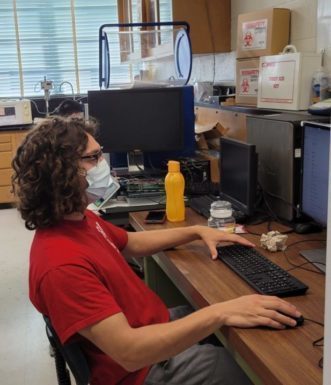Darianna Rios-Pedraza
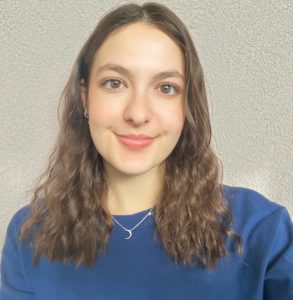 Institute: Texas A & M International University
Institute: Texas A & M International University
TAMU Mentor: Dr. Chao Ma
Graduate Student Mentor: Mohammadamin Moghadasi
Research Project: Binder Jetting Additive Manufacturing of Ceramics: Improvement of Part Quality
Description:
Evan Shane Forester
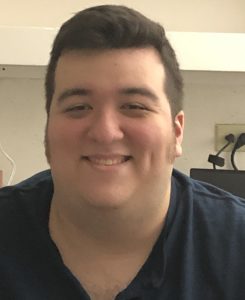 Institute: The University of Texas at San Antonio
Institute: The University of Texas at San Antonio
TAMU Mentor: Dr. Amarnath Banerjee
Graduate Student Mentor: Harshini Jayabal
Research Project: Industry 4.0
Description:
Industry 4.0 is considered as the integration of cyber learning systems with a mechanical device or system of devices to create a digital twin and collect relevant system data in real-time. This can be used to create predictive maintenance plans for machinery and improve existing designs by identifying and removing slow processes in a manufacturing environment
Rachel Elizabeth Mead
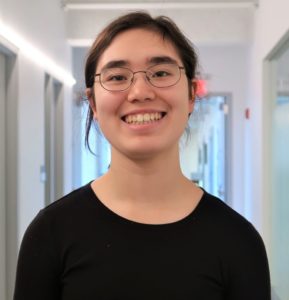 Institute: Cornell University
Institute: Cornell University
TAMU Mentor: Dr. Yu Ding
Graduate Student Mentor: Adaiyibo E. Kio
Research Project: Environmental Factor Predictions and Power Forecasting for Wind Turbines
Description:
The power production of wind turbines depends heavily on the ever-changing environmental factors, especially wind speed. Accurate power production forecasts will substantially benefit wind energy providers. Wind energy providers will be able to accurately determine whether they can supply the energy to the grid for which they are contracted. If a wind farm does not produce enough power, they must purchase the power from somewhere else, and if they have a surplus, they can sell it off. Having accurate predictions allows wind energy producers to have the time to buy and sell power without resorting to paying exorbitant prices or wasting their surplus. This research aims to achieve this goal by examining trends in real data instead of using complex physics. We will consider several environmental factors that affect power production. Lastly, many wind farms make their own predictions, usually every hour for the upcoming twenty-four hours. We want to determine how accurate these predictions are based on the real data and develop improved models for predicting power.
Jarek Ronald Gryskiewicz
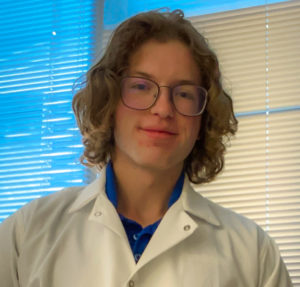 Institute: Arizona State University-Tempe
Institute: Arizona State University-Tempe
TAMU Mentor: Dr. Shiren Wang
Graduate Student Mentor: Jared Gibson
Research Project: Voxel Bio-Printing
Description:
Create the hardware and software for a computed axial lithography (CAL) 3D printer to be used in studying radial carbon nanotube alignment in viscous resin. We will continue to use this 3D printer to study resin biomaterials and how they can be used to create 3D printed anatomical body parts.
Ahmad Abu Nada
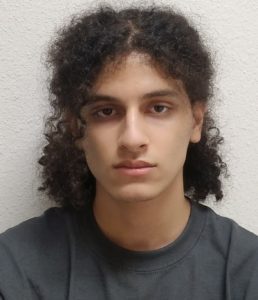 Institute: Arizona State University-Tempe
Institute: Arizona State University-Tempe
TAMU Mentor: Dr. Ranjana Mehta and Dr. Prabhakar Pagilla
Graduate Student Mentor: Yinsu Zhang
Research Project: Identifying Cyber intrusions through human-robot interaction metrics
Description:
The goal is to assess cyber intrusions by focusing on monitoring human-robot interaction metrics. We will be harnessing human data (eye-tracking, brain imaging, physiological responses) and external sensor data (camera feed) to detect cyber intrusion manifestations (i.e., unreliable robot behaviors).
Sebastian Vazquez
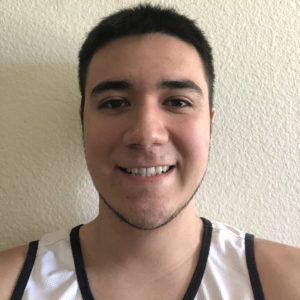 Institute: University of California-Merced
Institute: University of California-Merced
TAMU Mentor: Dr. ChaBum Lee
Graduate Student Mentor: Heebum Chun
Research Project: Preliminary Understanding of Li-Ion Battery Charging and Discharging Dynamic Behavior by Stethoscopy
Description:
The goal of this project is to monitor the movement of ions in a battery by using a frequency sensor and 3D surface reconstruction by using stereoscopic imaging.
Alexis Alvidrez
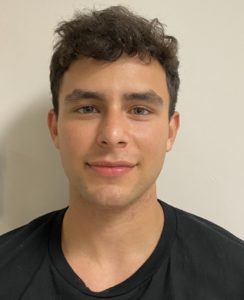 Institute: The University of Texas at El Paso
Institute: The University of Texas at El Paso
TAMU Mentor: Dr. Heng Pan
Graduate Student Mentor: Xiangtao Gong
Research Project: Flexible electronics manufacturing by aerosol printing
Description:
With aerosol jet printing, the future of manufacturing flexible electronics is promising. In this project, we explore a method of printing layers of polyimide (insulator) with a layer of processed silver nanoink (conductive material). This specimen is then transferred to a stretchable surface. Optimizing the method of transfer and making the process inexpensive and scalable is the goal of this project. This implies making, or finding another substrate that is accessible, since it cannot be any arbitrary substrate.
Ryan Ording
 Institute: North Carolina State University
Institute: North Carolina State University
TAMU Mentor: Dr. Hong Liang
Graduate Student Mentor: Ajinkya Raut
Research Project: Fabrication of Nanocomposite membranes for water filtration
Description:
Wastewater treatment by membrane filtration is a widely used technique. The goal is to design and fabricate membranes to filter water, both to understand how these membranes work and create better ones. These membranes will be made from many different polymers, with multiple kinds of nanoparticles suspended in them.
Sriniket Rachuri
 Institute: University of Maryland-College Park
Institute: University of Maryland-College Park
TAMU Mentor: Dr. Dinakar Sagapuram
Graduate Student Mentor: Harshit Chawla
Research Project: An Open Source Toolbox for Determining Constitutive Material Parameters
Description:
Using Constitutive Laws and approximation methods to estimate the properties of materials in the plastic region
David Allen Bekele
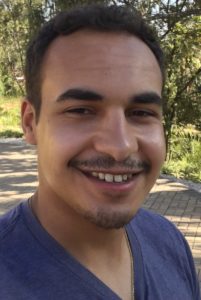 Institute: Eastern Connecticut State University
Institute: Eastern Connecticut State University
TAMU Mentor: Dr. Arun Srinivasa
Graduate Student Mentor: Naveen Thomas
Research Project: Comparison of damage in shape-memory polymer due to milling and laser cutting
Description:
Compare different manufacturing processes in shape-memory polymers by taking samples and carefully cutting them
Jiaqing Li
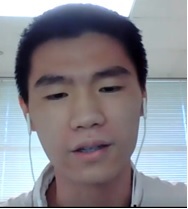 Institute: Oregon State University
Institute: Oregon State University
TAMU Mentor: Dr. Amir Asadi
Graduate Student Mentor: Ozge Kaynan
Research Project: Predicting the Mechanical Properties of Carbon Fiber Reinforced Polymers from Scanning Electron Microscope Images with Machine Learning.
Description:
The goal is to be able to predict the mechanical properties of composite materials with SEM images. For that we will write the respective code to take in SEM images and crop them. The images have to be saved and output multiple different orientations for machine learning. This will also lead to eliminating the need to make composites, characterizing them, etc.
Sabina Stephany Arroyo
Institute: The University of Texas at El Paso
TAMU Mentor: Dr. Sarah Wolff
Graduate Student Mentor: Mahsa Valizadeh
Research Project: Machine Learning of Metals in Additive Manufacturing Process
Description:
Over time, technology has advanced in an extraordinary way, as well as the different additive manufacturing processes of the different materials, however it is not 100% viable, due to the porosity caused by the laser in the different types of metals. The project consists of the analysis of data, both x-rays and thermal images of the additive manufacturing process with different types of metals. The images obtained, which are captured every 20 microseconds, will go through a cleaning and labeling process. Subsequently, it is possible to predict what will happen to the material when it is subjected to this process.
Kerry Zeyun Wang
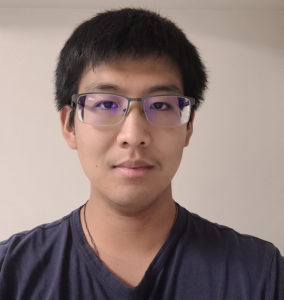 Institute: College of William and Mary
Institute: College of William and Mary
TAMU Mentor: Dr. Satish Bukkapatnam/ Dr. Bimal Nepal
Graduate Student Mentor: Parth Dave
Research Project: Sensor fusion and analysis for smart manufacturing
Description:
Different tasks in manufacturing equipment produce different sensor readings. By capturing real-time data from the equipment, we can analyze it to determine what the equipment is currently doing. We can also look for signs that the equipment is behaving abnormally and stop it to reduce wasted time and materials.

